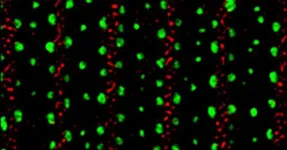(Press-News.org) Less than half of patients with malignant ureteral obstruction (MUO) – a serious complication of advanced cancer, with a poor prognosis – receive palliative care (PC) for their condition, reports a paper in the January issue of Urology Practice®, an Official Journal of the American Urological Association (AUA). The journal is published in the Lippincott portfolio by Wolters Kluwer.
Hospice care can promote patient comfort while avoiding aggressive and invasive treatments for MUO patients nearing the end of life, according to the new research led by Michael D. Felice, MD, of Loyola University Medical Center, Maywood, Ill. "Earlier referral to palliative care might help to promote informed decisions about preferences for care among patients with MUO," Dr. Felice comments.
New insights into palliative care use in MUO
Malignant ureteral obstruction is a condition in which the urinary tract is blocked due to advanced cancer. Patients with MUO have limited life expectancy, and some spend much of their remaining life in the hospital. Over time, MUO leads to buildup of urine within the kidneys, a condition called hydronephrosis. Decompression treatments can relieve the buildup, but these are invasive procedures with high complication rates and sometimes questionable benefits.
For patients with advanced cancer, palliative care aims to improve symptoms and mental and spiritual health while ensuring that any further cancer treatments reflect the patients' goals of care. Hospice care, a subset of palliative care, is an option for patients with expected survival of less than six months.
"Concurrent dedicated palliative care services and oncologic treatment is recommended for patients with advanced cancer," Dr. Felice and colleagues write. However, the use of palliative care by patients with MUO remains unclear. The researchers evaluated the use of palliative care and hospice care among 115 patients diagnosed with MUO between 2014 and 2020.
On review of medical records, only 39% of patients with MUO received palliative care. On average, there was a two-month delay between MUO diagnosis and palliative care evaluation. Just five of 45 patients were referred to palliative care before decisions regarding decompression treatment.
Urologists could play key role in early palliative care referral
Fifty-four percent of patients received hospice care, starting a median of 144 days after MUO diagnosis. Median time from hospice initiation to death was 12 days.
Eighty-five percent of patients died or were presumed to have died at the time of the study. Median time from MUO diagnosis to death was 141 days, with similar survival for patients who did and did not receive palliative care.
Of the patients who died, 43% had high healthcare use – based on factors such as repeated emergency department visit or hospitalizations during the last month of life, or in-hospital death. Among patients who did not receive hospice care, 86% had high end-of-life healthcare use. "This highlights the impact of hospice in facilitating end-of-life discussion and enabling patients to decide how and where they spend their last days," the researchers write. On adjusted analysis, patients receiving hospice care were 97% less likely to have high healthcare use at the end of life.
Patients with MUO "are ideal candidates for palliative care consultation to help navigate the complexities of multidisciplinary care and guide decision-making," Dr. Felice and coauthors write. "Ideally, patients would be referred to PC after MUO diagnosis and prior to the decision regarding urinary decompression."
The researchers note that 80% of study patients with MUO saw a urologist at some point during their care. They conclude: "Urologists may be particularly poised to promote interdisciplinary collaboration and initiate conversations regarding incorporating palliative care due to our multifaceted involvement in caring for patients with MUO."
Read Article [ The Current Status of Palliative Care, Hospice, and End-of-Life Health Care Utilization in Patients With Malignant Ureteral Obstruction ]
Wolters Kluwer provides trusted clinical technology and evidence-based solutions that engage clinicians, patients, researchers and students in effective decision-making and outcomes across healthcare. We support clinical effectiveness, learning and research, clinical surveillance and compliance, as well as data solutions. For more information about our solutions, visit https://www.wolterskluwer.com/en/health.
###
About Urology Practice
An Official Journal of the American Urological Association (AUA), Urology Practice focuses on clinical trends, challenges and practice applications in the four areas of Business, Health Policy, the Specialty and Patient Care. Information that can be used in everyday practice will be provided to the urology community via peer-reviewed clinical practice articles (including best practices, reviews, clinical guidelines, select clinical trials, editorials and white papers), "research letters" (brief original studies with an important clinical message), the business of the practice of urology, urology health policy issues, urology education and training, as well as content for urology care team members.
About the American Urological Association
Founded in 1902 and headquartered near Baltimore, Maryland, the American Urological Association is a leading advocate for the specialty of urology, and has more than 23,000 members throughout the world. The AUA is a premier urologic association, providing invaluable support to the urologic community as it pursues its mission of fostering the highest standards of urologic care through education, research and the formulation of health care policy. To learn more about the AUA visit: www.auanet.org
About Wolters Kluwer
Wolters Kluwer (EURONEXT: WKL) is a global leader in information, software, and services for professionals in healthcare, tax and accounting, financial and corporate compliance, legal and regulatory, and corporate performance and ESG. We help our customers make critical decisions every day by providing expert solutions that combine deep domain knowledge with specialized technology and services.
Wolters Kluwer reported 2022 annual revenues of €5.5 billion. The group serves customers in over 180 countries, maintains operations in over 40 countries, and employs approximately 20,900 people worldwide. The company is headquartered in Alphen aan den Rijn, the Netherlands.
For more information, visit www.wolterskluwer.com, follow us on LinkedIn, Facebook, and YouTube.
END
Palliative care is underused for patients with malignant urinary obstruction
Hospice patients less likely to have high healthcare use at end of life, reports Urology Practice®
2023-12-21
ELSE PRESS RELEASES FROM THIS DATE:
JCEHP supplement aims to disrupt assumptions about continuing professional development
2023-12-21
December 7, 2023 —The Journal of Continuing Education in the Health Professions (JCEHP) has published a supplement, "Conceptual Advances in Continuing Professional Development in the Health Professions," in which scholars of continuing professional development (CPD) creatively examine prevailing assumptions and propose new theoretical frameworks and empirical insights. Publication of the supplemental issue is supported by the Society for Academic Continuing Medical Education (SACME). JCEHP, the official journal of the Alliance for Continuing Education in the Health Professions, ...
Researchers awarded $3 million to develop AI to better detect aggressive prostate cancer
2023-12-21
Researchers at the UCLA Health Jonsson Comprehensive Cancer Center have received a five-year, $3 million grant from the National Cancer Institute to identify novel cancer biomarkers and develop AI that can detect and predict aggressive prostate cancer to help avoid unnecessary treatments and their associated negative side effects.
Despite recent advancements, prostate cancer remains a common and serious health issue for men, and current methods of screening and risk assessment can often lead to overdiagnosis and overtreatment. About 90% of people diagnosed with prostate cancer receive treatment, even though ...
GPCR structure: Research reveals molecular origins of function for a key drug target
2023-12-21
Through an international collaboration, scientists at St. Jude Children’s Research Hospital leveraged data science, pharmacology and structural information to conduct an atomic-level investigation into how each amino acid in the receptor that binds adrenaline contributes to receptor activity in the presence of this natural ligand. They discovered precisely which amino acids control the key pharmacological properties of the ligand. The adrenaline receptor studied is a member of the G protein-coupled receptor (GPCR) family, and this family is the target of one-third of all Food and Drug Administration (FDA)-approved drugs. Thus, understanding how ...
Structures of Parkinson’s disease-linked proteins offer a framework for understanding how they work together
2023-12-21
Scientists at St. Jude Children’s Research Hospital revealed the complex structure of two Parkinson’s disease-related proteins, both of which are implicated in late-onset cases. Leucine-rich repeat kinase 2 (LRRK2) is a protein kinase that modifies other proteins in a process called phosphorylation; Rab29, a member of the Rab GTPase family that regulates cellular trafficking, modulates the activity of LRRK2. How Rab29 and LRRK2 work synergistically to cause Parkinson’s disease remains ...
Male breast cancer diagnosis fuels groundbreaking treatment tool
2023-12-21
Doctors diagnosed Christopher Gregg, Ph.D., member of the Nuclear Control of Cell Growth and Differentiation Program at Huntsman Cancer Institute at the University of Utah (the U) and neuroscientist and professor of neurobiology and human genetics at the U, with stage 4 metastatic breast cancer in 2018. At that point, he started thinking of ways to improve his treatment.
“The core problem of metastatic cancer is it evolves,” says Gregg. “There may be a treatment that works today but eventually ...
NASA’s Hubble watches ‘spoke season’ on Saturn
2023-12-21
This photo of Saturn was taken by NASA's Hubble Space Telescope on October 22, 2023, when the ringed planet was approximately 850 million miles from Earth. Hubble's ultra-sharp vision reveals a phenomenon called ring spokes.
Saturn's spokes are transient features that rotate along with the rings. Their ghostly appearance only persists for two or three rotations around Saturn. During active periods, freshly-formed spokes continuously add to the pattern.
In 1981, NASA's Voyager 2 first photographed the ring spokes. NASA's Cassini orbiter also saw the spokes during its 13-year-long mission that ended in 2017.
Hubble continues ...
Astronomers detect seismic ripples in ancient galactic disk
2023-12-21
A new snapshot of an ancient, far-off galaxy could help scientists understand how it formed and the origins of our own Milky Way.
At more than 12 billion years old, BRI 1335-0417 is the oldest and furthest known spiral galaxy in our universe.
Lead author Dr Takafumi Tsukui said a state-of-the-art telescope called ALMA allowed them to look at this ancient galaxy in much greater detail.
“Specifically, we were interested in how gas was moving into and throughout the galaxy,” Dr Tsukui said.
“Gas is a key ingredient for forming stars and can give ...
Exercise prescription: Pioneering the "third pole" for clinical health management
2023-12-21
Professor Chen Shiyi's team at Huashan Hospital of Fudan University commented on the concept, policy, development and prospect of exercise prescription in the context of " Health for All", which was published in Research (10.34133/research.0284) under the title of " Exercise Prescription: Pioneering the “Third Pole” for Clinical Health Management".
Modern lifestyles have led to reduced physical activity and a rise in chronic diseases from a young age. Exercise ...
Inside the matrix: Nanoscale patterns revealed within model research organism
2023-12-21
Species throughout the animal kingdom feature vital interfaces between the outermost layers of their bodies and the environment. Intricate microscopic structures—featured on the outer skin layers of humans, as one example—are known to assemble in matrix patterns.
But how these complex structures, known as apical extracellular matrices (aECMs) are assembled into elaborately woven architectures has remained an elusive question.
Now, following years of research and the power of a technologically advanced instrument, University of California San Diego scientists have unraveled the underpinnings ...
Urology treatment studies show increased reporting of harmful effects
2023-12-21
Waltham — December 11, 2023 —
In recent years, clinical trial reports in major urology journals have been more likely to include data on harmful effects of treatments, reports a study in the January issue of The Journal of Urology®, an Official Journal of the American Urological Association (AUA). The journal is published in the Lippincott portfolio by Wolters Kluwer.
"Our analysis finds a marked increase in reporting of potential harms in randomized treatment trials ...
LAST 30 PRESS RELEASES:
Making lighter work of calculating fluid and heat flow
Normalizing blood sugar can halve heart attack risk
Lowering blood sugar cuts heart attack risk in people with prediabetes
Study links genetic variants to risk of blinding eye disease in premature infants
Non-opioid ‘pain sponge’ therapy halts cartilage degeneration and relieves chronic pain
AI can pick up cultural values by mimicking how kids learn
China’s ecological redlines offer fast track to 30 x 30 global conservation goal
Invisible indoor threats: emerging household contaminants and their growing risks to human health
Adding antibody treatment to chemo boosts outcomes for children with rare cancer
Germline pathogenic variants among women without a history of breast cancer
Tanning beds triple melanoma risk, potentially causing broad DNA damage
Unique bond identified as key to viral infection speed
Indoor tanning makes youthful skin much older on a genetic level
Mouse model sheds new light on the causes and potential solutions to human GI problems linked to muscular dystrophy
The Journal of Nuclear Medicine ahead-of-print tip sheet: December 12, 2025
Smarter tools for peering into the microscopic world
Applications open for funding to conduct research in the Kinsey Institute archives
Global measure underestimates the severity of food insecurity
Child survivors of critical illness are missing out on timely follow up care
Risk-based vs annual breast cancer screening / the WISDOM randomized clinical trial
University of Toronto launches Electric Vehicle Innovation Ontario to accelerate advanced EV technologies and build Canada’s innovation advantage
Early relapse predicts poor outcomes in aggressive blood cancer
American College of Lifestyle Medicine applauds two CMS models aligned with lifestyle medicine practice and reimbursement
Clinical trial finds cannabis use not a barrier to quitting nicotine vaping
Supplemental nutrition assistance program policies and food insecurity
Switching immune cells to “night mode” could limit damage after a heart attack, study suggests
URI-based Global RIghts Project report spotlights continued troubling trends in worldwide inhumane treatment
Neutrophils are less aggressive at night, explaining why nighttime heart attacks cause less damage than daytime events
Menopausal hormone therapy may not pose breast cancer risk for women with BRCA mutations
Mobile health tool may improve quality of life for adolescent and young adult breast cancer survivors
[Press-News.org] Palliative care is underused for patients with malignant urinary obstructionHospice patients less likely to have high healthcare use at end of life, reports Urology Practice®





